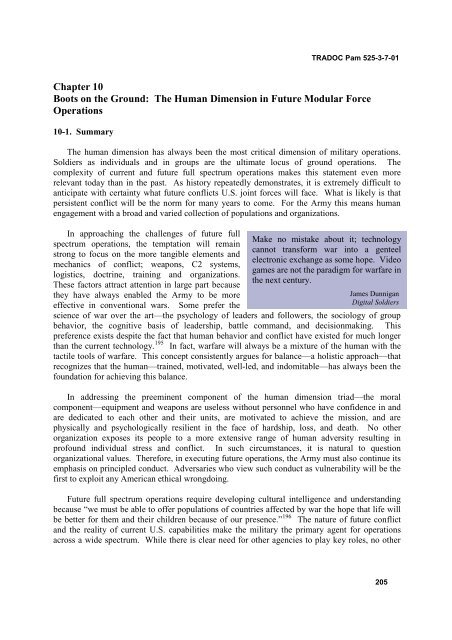TRADOC Pam 525-3-7-01 - TRADOC - U.S. Army
TRADOC Pam 525-3-7-01 - TRADOC - U.S. Army
TRADOC Pam 525-3-7-01 - TRADOC - U.S. Army
- No tags were found...
You also want an ePaper? Increase the reach of your titles
YUMPU automatically turns print PDFs into web optimized ePapers that Google loves.
<strong>TRADOC</strong> <strong>Pam</strong> <strong>525</strong>-3-7-<strong>01</strong>Chapter 10Boots on the Ground: The Human Dimension in Future Modular ForceOperations10-1. SummaryThe human dimension has always been the most critical dimension of military operations.Soldiers as individuals and in groups are the ultimate locus of ground operations. Thecomplexity of current and future full spectrum operations makes this statement even morerelevant today than in the past. As history repeatedly demonstrates, it is extremely difficult toanticipate with certainty what future conflicts U.S. joint forces will face. What is likely is thatpersistent conflict will be the norm for many years to come. For the <strong>Army</strong> this means humanengagement with a broad and varied collection of populations and organizations.In approaching the challenges of future fullspectrum operations, the temptation will remainstrong to focus on the more tangible elements andmechanics of conflict; weapons, C2 systems,logistics, doctrine, training and organizations.These factors attract attention in large part becausethey have always enabled the <strong>Army</strong> to be moreeffective in conventional wars. Some prefer theMake no mistake about it; technologycannot transform war into a genteelelectronic exchange as some hope. Videogames are not the paradigm for warfare inthe next century.James DunniganDigital Soldiersscience of war over the art—the psychology of leaders and followers, the sociology of groupbehavior, the cognitive basis of leadership, battle command, and decisionmaking. Thispreference exists despite the fact that human behavior and conflict have existed for much longerthan the current technology. 195 In fact, warfare will always be a mixture of the human with thetactile tools of warfare. This concept consistently argues for balance—a holistic approach—thatrecognizes that the human—trained, motivated, well-led, and indomitable—has always been thefoundation for achieving this balance.In addressing the preeminent component of the human dimension triad—the moralcomponent—equipment and weapons are useless without personnel who have confidence in andare dedicated to each other and their units, are motivated to achieve the mission, and arephysically and psychologically resilient in the face of hardship, loss, and death. No otherorganization exposes its people to a more extensive range of human adversity resulting inprofound individual stress and conflict. In such circumstances, it is natural to questionorganizational values. Therefore, in executing future operations, the <strong>Army</strong> must also continue itsemphasis on principled conduct. Adversaries who view such conduct as vulnerability will be thefirst to exploit any American ethical wrongdoing.Future full spectrum operations require developing cultural intelligence and understandingbecause “we must be able to offer populations of countries affected by war the hope that life willbe better for them and their children because of our presence.” 196 The nature of future conflictand the reality of current U.S. capabilities make the military the primary agent for operationsacross a wide spectrum. While there is clear need for other agencies to play key roles, no other205



